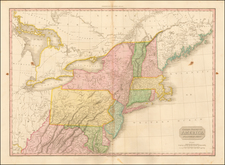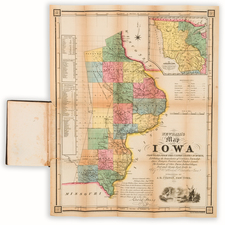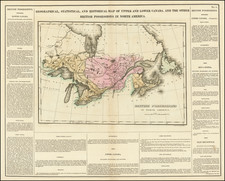Strking grand format birdseye view of Chicago, drawn 3 years after the Great Chicago Fire devasated the City and published by America's most commerciall successful printseller, Currier & Ives.
In the years following the fire, Chicago rebuilt and became America'a first Mid-American City of Commerce. In this fine original lithograph, the booming metropolis of Chicago is shown on a scale of commerce and grandeur equal to any city in America or Europe. A thriving water front commerce gives way to a large and important urbanized American City, which was then serving as the northern gateway to the fast growing industrialized midwetstern US.
Originally printed in 1874, this example was re published in 1892, in anticipation of the opening of the World's Columbian Exposition of 1893. The World's Columbian Exposition - also known as The Chicago World's Fair - was a World's Fair held in Chicago in 1893 to celebrate the 400th anniversary of Christopher Columbus's arrival in the New World. The fair had a profound effect on architecture, the arts, Chicago's self-image, and American industrial optimism. The Chicago Columbian Exposition was, in large part, designed by Daniel Burnham and Frederick Law Olmsted. Over 27 million people attended the exposition during its six-month run. Its scale and grandeur far exceeded other world fairs. The fair became a symbol of the emerging American Exceptionalism, much in the same way that the Great Exhibition became a symbol of the Victorian era United Kingdom. In addition to recognizing the 400th anniversary of the discovery of the New World, the fair also served to show the world that Chicago had risen from the ashes of the Great Chicago Fire, which had destroyed much of the city in 1871.
The original artwork for this View was prepared by Charles Parsons and Lyman Atwater, who worked as artists and lithographers for Currier & Ives. Their work shows in fine detail the spread of the city of Chicago with lake Michigan and the Chicago river in the foreground. The fine view depicts a thriving harbor of Chicago with steam- and sailing boats in the foreground, a gleaming modern rain station and lively boat traffic on the Chicago river. The sketch of the individual houses, churches, parks and larger buildings is highly detailed, in the very background you recognize the expansion of the settlement towards the green fields, symbolic of the limitless growth potential for the city.
Because Birdseye Views were essentailly ephemeral in nature (promotional items intended to capture a snapshot of a place at one particular point in time) and not issued in bound volumes, the survival rate is relatively low, especially examples which were colorized at the time and displayed publically. Unlike maps and views bound into atlases, these views were largely gone withing a few years of their original publication.
As a medium of expression, the view would later give way to the panoramic photograph and later aerial phtograph, making these grand panoramic lithographs the final link between the Italian landscape painters of the 14th and 15th Centuries, the great town books of Braun & Hogenberg, the multi-sheet works of the great 17th and 18th Century European City illustrators, and the American tradition of promoting cities, large and small, with idealized images.
While Currier & Ives prints are by no means rare, the survival rate of their great large format city views is surprisingly small and views such as this one can now be considered rare on the market. The present example was acquired at a German Auction house in late 2009 and is generally reflective of the wide spread interest, especially in Germany, in th growth of the US and commerce opportunities not then available in Europe.









![[Eastern Sheet -- Ohio] Post Road Map of the States of Ohio and Indiana with Adjacent Parts of Pennsylvania Michigan Illinois Kentucky and West Virginia Showing Post Offices With The Intermediate Distances and Mail Routes In Operation On the !st of February 1885 . . .](https://storage.googleapis.com/raremaps/img/small/44153.jpg)


![[ Ohio - Seven Ranges ] Plat of the Seven Ranges of Townships being Part of the Territory of the United States N.W. of the River Ohio which by a late act of Congress are directed to be sold . . . 1785](https://storage.googleapis.com/raremaps/img/small/82394.jpg)

